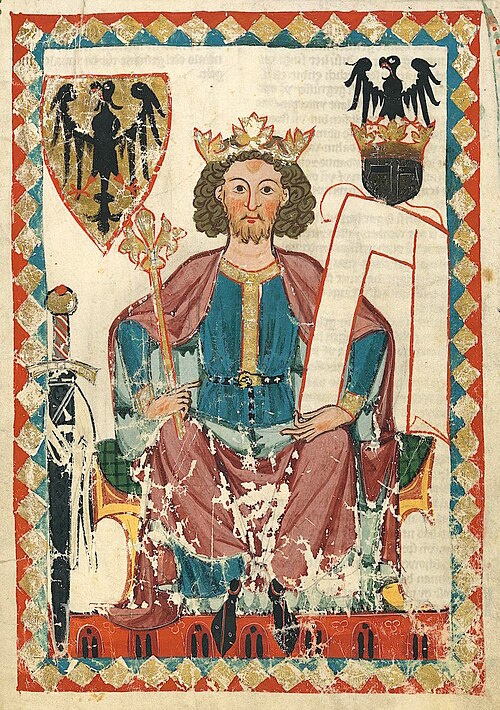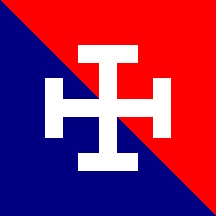Teutonic Cross
also known in heraldry as Potent Cross

By 1198, they became a religious military order of crusaders, first fighting in the Holy Land and later in Prussia and Lithuania. The order secured high status for themselves, but this ebbed in the 15th century. It was finally broken up by Napoleon in 1809 who gave the order's main assets to his allies of the Confederation of the Rhine.

Emperor Henry VI
Their founder, Henry VI, was physically not a very imposing character, but he made up for this with his strong diplomatic skills - and a strong army. In addition to being the Holy Roman Emperor, Henry was King of Germany and was later crowned King of Sicily. It was from here that 60,000 soldiers rode off as knights to join the Third Crusade.
The knights didn't spend all their time killing people however; they also guarded Christian pilgrims who visited a tented hospital at the city of Acre. From this, the Teutonic Order was established, and the knights worked alongside two other Jerusalem orders - the Templars and the Hospitallers. Pope Innocent III granted the Teutonic Knights the honour of wearing a white habit with a black cross.
As with today's crusades in the Middle East, there was a higher objective than merely spreading an ideology; it was about empire-building, acquiring as much property and power as possible. Not content with the better part of Europe, the king wanted more. (...Moors?)
The knights conquered Acre, which probably seemed like a good idea at the time, but here we see yet another example of the futility of war, since the Muslims reclaimed the city about 100 years later.
In the 13th century, they turned their attention to attacking pagans in Prussia. Following that conquest, Germans and Poles moved in as settlers; thus began a two-hundred-year process of Germanising this part of Eastern Europe.
Today, the order has its main presence in Vienna as a Catholic hospital order. (There's also a Protestant branch in Netherlands. It still retains knights to this day, who must pay for the privilege of being in the Order, and they control several schools and hospitals. In emergencies such as war, they forgo their predecessor's sword-wielding and rampaging ways and provide an ambulance service, returning to their original role as hospitallers.
The Teutonic Cross appeared for a short time on the flag of the Monatio (Mouvement National); a relatively small nationalist militia in Cambodia until c. 1975. They welcomed the arrival of the Khmer Rouge who tolerated them for a while. The leader and members were soon executed during the chaotic period and it is unclear whether they were wiped out by the Khmer Rouge, or the local populace who felt betrayed. (The current Wagner mercenaries should take note!)
It's unknown whether the cross was chosen for its early Teutonic history, and we'd welcome further information about this flag.
The cross was white but the background triangles varied; sometimes red and blue, sometimes red and black (matching the members' uniform). The choice may have been restricted to whatever material was available at the time. Being a battle flag, it invariably appeared square rather than the usual oblong flag shape.
In heraldry, this cross is aptly named a Potent Cross (Fr: Potencée); potent meaning 'strong' and also an old word for 'crutch', 'support' or 'bracket'.
The angularity of this cross makes it popular for logo design, monograms (such as ICXC), or a date for the year's Paschal Candle.

Potent
Crossed
A Potent Crossed Cross is similar to the battlements of the Crenel Cross.







